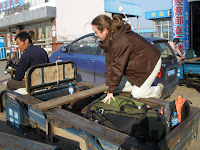

 Lijiang is about a three hour drive north from Dali. Stefan and I met Jo and Judy at our guesthouse and the four of us made plans to hike the Tiger Leaping Gorge together. We only spent a day and a half in the touristy city of Lijiang. One night we had a local dinner of grilled chuan which is meat, veggies or tofu on a stick with hot spices added as you like. You can find vendors all over China late into the night.
Lijiang is about a three hour drive north from Dali. Stefan and I met Jo and Judy at our guesthouse and the four of us made plans to hike the Tiger Leaping Gorge together. We only spent a day and a half in the touristy city of Lijiang. One night we had a local dinner of grilled chuan which is meat, veggies or tofu on a stick with hot spices added as you like. You can find vendors all over China late into the night. 


From Lijiang we took a bus to the start of the gorge. It was a hot day and the gorge ranges between 1600 to 10,800 feet. It's said to be one o the world's deepest river canyons. A part of the Yangtze River, locally known as Golden Sands River, runs through the Jade Snow Dragon and Haba Xueshan mountains. We were hiking uphill at a higher altitude for the entire first day. There was a local Naxi man (Naxi is one of the native ethnic groups in the area) who followed us from the start of the path. He was hoping one of us would collapse and need to use his horse. I was the slowest and he kept walking behind me and warning me of the dreaded "
 28 bends"! I kept telling him in Mandarin, "Wo bu yao ma!" which means, "I don't want the horse!". Every locale person we met along the way kept warning us of the 28 bends which was
28 bends"! I kept telling him in Mandarin, "Wo bu yao ma!" which means, "I don't want the horse!". Every locale person we met along the way kept warning us of the 28 bends which wasnothing compared to what we had to climb to get to them. The bends were just a set of switchbacks and the final steep ascent we had for the day. Once at the top our group, which grew by t
 wo, posed for this photo.
wo, posed for this photo.We stayed at the Five Fingers Guesthouse which is the home of the hospitable Mr. Li and his family. We met two South African travelers, Bryce and Leah, and our group celebrated the seven hours of
 hiking with a great meal, several bottles of pijiu and some of Mr. Li's homemade plum wine.
hiking with a great meal, several bottles of pijiu and some of Mr. Li's homemade plum wine.The guesthouse is named after the set of mountains we had as our view. T
 he five peaks resemble five fingers.
he five peaks resemble five fingers.We set out early the next morning wanting to hike to a guesthouse perched at the top of the gorge where you can descend down to the Tiger Leaping rock. Legend is that a tiger used the rock as a stepping stone to get to the other side of the gorge. Signs on the trail told us we only had an hour but the hike turned out to be about twice as log so we were happy to finally fill up on some breakfast.
After that we had the choice of three locations to take a trail down and then a set of ladders back to the top. The trails and ladders are maintained by locals that run guesthouses. We started our trek down to the river
 at an old woman's path. She collected 10 RMB (about 1.50 US) to use her path. The trail is rather treacherous and the ladders were even more scary for me, someone not particularly keen of heights. The river itself was fast flowing and we soaked our aching feet in
at an old woman's path. She collected 10 RMB (about 1.50 US) to use her path. The trail is rather treacherous and the ladders were even more scary for me, someone not particularly keen of heights. The river itself was fast flowing and we soaked our aching feet in the cold water.
the cold water.After climbing up the rickety ladders (there were three sets) we rested with the old woman who collects the fee for the trail. We had a picture taken with her and her grand kids. The kid loved the trail mix that I shared with them and I ended up giving them the bag.









































